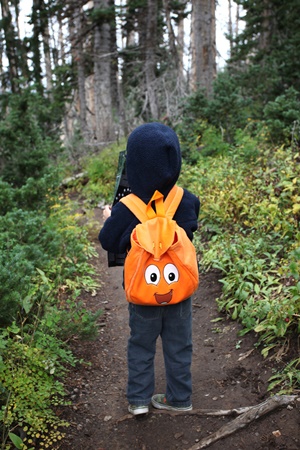Trails
Brian Head is a rustic mountain community where people and nature co-exist. Here are some tips for coexisting with nature during your trail experience:
Thin Air is Not Just a Figure of Speech
Sunscreen is Your Friend
Lightning is Not Your Friend
Don't Like the Weather? Wait 5 minutes.
Say it With Me Now...Hydrate!
You See That Cliff? Don't Walk Off It
You're Not Bear Grylls, Bring Stuff With You
Thin Air is Not Just a Figure of Speech
Most of the trails located here are between 9,000 and 11,000 feet. Sometimes the most fit trail users, if not acclimated to the high altitude, find themselves winded after a hike, even over relatively flat terrain. Persons with chronic respiratory or cardiac problems are advised to be extra cautious and assess their own abilities when considering hiking or other strenuous activities at high elevation. Some people are susceptible to "altitude sickness," and can experience headaches and nausea. The best treatment for any of these symptoms is to stay hydrated and move to a lower altitude.
Sunscreen is Your Friend
Ultraviolet light exposure is about 50% greater at this altitude. Sunburn can occur very rapidly, particularly at mid-day. Snow reflects up to 80% of the UV rays and further increases risk. Wear sunglasses, a wide-brimmed hat, sunscreen, and UV protective lip balm when hiking, and replenish sunscreen frequently to protect yourself.
Lightning is Not Your Friend
The safest place to be in a lightning storm is inside an enclosed building or inside a closed vehicle. If lightning is striking within five miles of your location, head for shelter and do not stay in open, exposed areas. Make sure you're not the highest object in an area, and do not seek shelter under a tree if it's the highest object around.
Don't Like the Weather, Wait Five Minutes
High mountain environments have unexpected and unpredictable weather events. While most summer days are clear, weather can change quickly and temperatures can drop drastically, even in mid-summer. Mountain thunderstorms can bring sudden cold, strong winds, rain, snow or hail, and dangerous lightning. Check the forecast before your hike and dress accordingly, and ALWAYS plan for cold and/or wet weather in the mountains, even if not in the forecast. Go prepared with a hat, warm jacket, and a shell layer for protection from rain and wind.
Say It with Me Now...Hydrate!
Because the air at higher elevation is cooler, visitors often do not drink enough fluids, simply because they don't feel "hot and thirsty." In reality, you may be unaware that your body is losing water from deep or more rapid breathing at altitude, and from unnoticeable perspiration that quickly evaporates into the dry air. Always bring plenty of water with you...and drink it.
You See That Cliff? Don't Walk Off It
Most trails in the Brian Head area are in a natural setting and are not highly developed. This means you will find naturally occurring hazards such as rocky and uneven surfaces, loose material on trails, steep grades, precipitous drop-offs, and exposed cliff edges. Wear sturdy hiking shoes and watch your step!
You're Not Bear Grylls, Bring Stuff with You
To ensure they are equipped to deal with unforeseen circumstances, well prepared trail users complete their day-pack with the following "ten essentials" while traveling in the remote areas:
1) Navigation - map, compass, GPS, Spanish conquistador
2) Insulation - sweater, jacket, deceased taun-taun
3) Illumination - flashlight, headlamp, Lumos charm
4) Nutrition - energy bars, trail mix, etc.
5) Hydration - water, water, water
6) Sun Protection - sunglasses, sunscreen, lip balm, hat
7) First-Aid Kit - basic trauma supplies
8) Fire Starters - waterproof matches, lighter
9) Tools - good pocket knife or multi-tool
10) Emergency Shelter - space blanket, plastic tube tent, or extra large trash bag
Help us keep Brian Head pristine by practicing the principles of Leave No Trace!
If you're in the backcountry quite a bit, you may be interested in acquiring a Utah Search & Rescue Assistance Card (it's basically search & rescue insurance). Check it out here.
Maps
Hiking & Biking Trails are shown below. Click here for ATV/OHV trails.
A physical version of these maps may be obtained at Brian Head Town Hall or local businesses in Brian Head.







